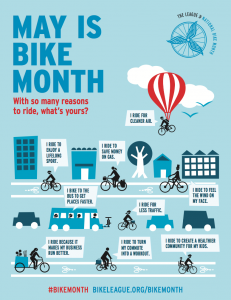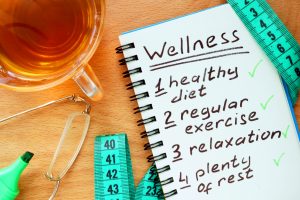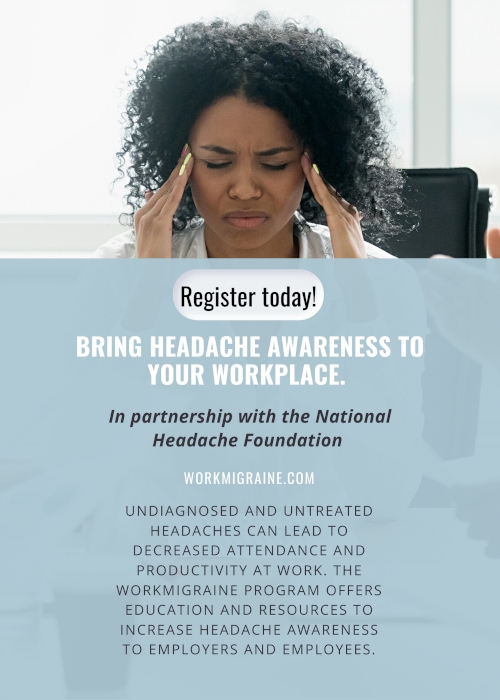How to Boost Your Immunity Naturally
Wednesday, June 30th, 2021
The past year and a half has made us all increasingly aware of our immunity. Some immune systems may be a little weaker after remaining in isolation for so long. There is a very simple and fun way to boost your immunity naturally. All it requires is stepping outside into the sunshine! The benefits of the outdoors are innumerable. Let’s explore just some of the benefits to your well-being both physically and mentally by being outside.
Boost Your Mood

One of the best and most obvious benefits of being out in the sun is vitamin D. Vitamin D is a great defense against illnesses including Covid-19. You can get vitamin D from a supplement, but its most potent source is from the sun itself.
Vitamin D is also a great, natural mood booster! Seasonal depression comes from a lack of vitamin D during the colder months when we may spend more time indoors. So if you ever feel a little out of sorts, go for a stroll in the sunshine or even just sit in the sun.
Not only is vitamin D from the sun a great benefit of being outdoors, so is the fresh air! Oxygen is our literal life force and it is most plentiful in nature. Witnessing the beauty of nature has a calming, peaceful effect. Taking in the sights and sounds of the world around us can remind us of a purpose bigger than ourselves.
Make Your Heart Healthy
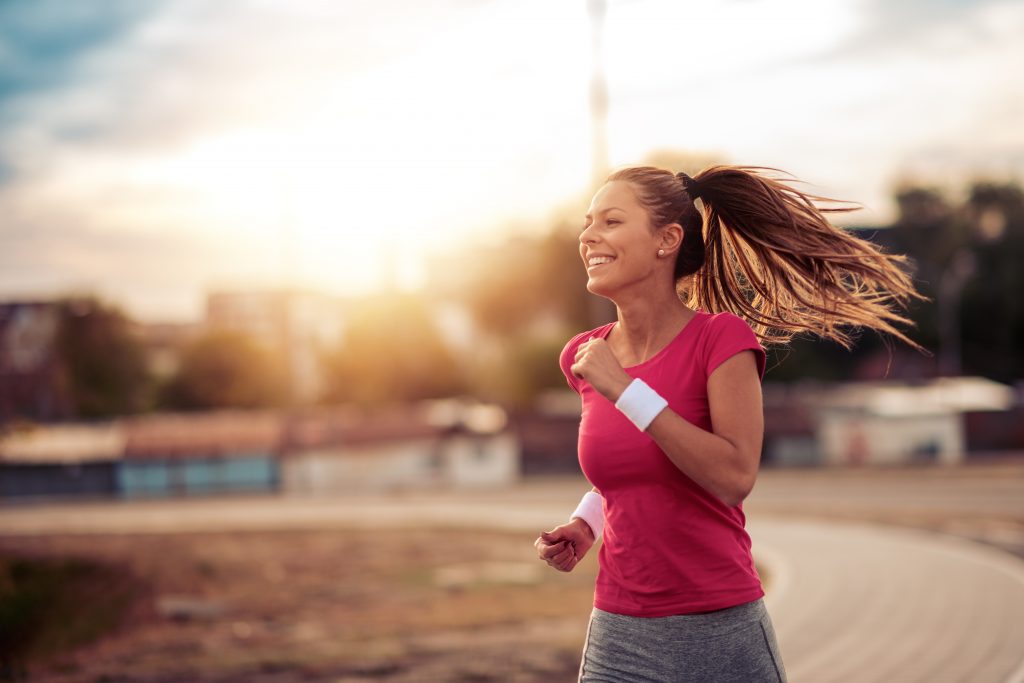
Another benefit to being outdoors is getting active! When you move your body, you increase blood flow to your heart. The heart is a large muscle. When we increase our heart rate through exercise, we are increasing the strength of that muscle.
Cardiovascular disease runs rampant throughout our nation. Simply going for a walk, playing a recreational sport, swimming or any light exercise can do wonders to decrease your risk of heart disease.
Exercise also releases lots of good endorphins, further contributing to our well-being. Endorphins block pain receptors and help decrease anxiety and depression. The more regularly you exercise, the better you will feel.
Build Community

Now that many restrictions have been lifted, it’s important to cultivate community. Getting outside allows you to meet the people around you, build relationships and find ways to serve your community.
From waving hello to a neighbor, playing a team sport, or attending an outdoor event, all of these activities contribute to a healthy, happy individual. We were made to be in community. We thrive when we lean on one another for support and comradery.
Being around other people outdoors is still a safer way to congregate in groups as well. Some exchange of “germs” between people is important to build up our immune systems. In small amounts, those germs train our bodies to fight and build antibodies to guard against disease.
A Break from Screen Time
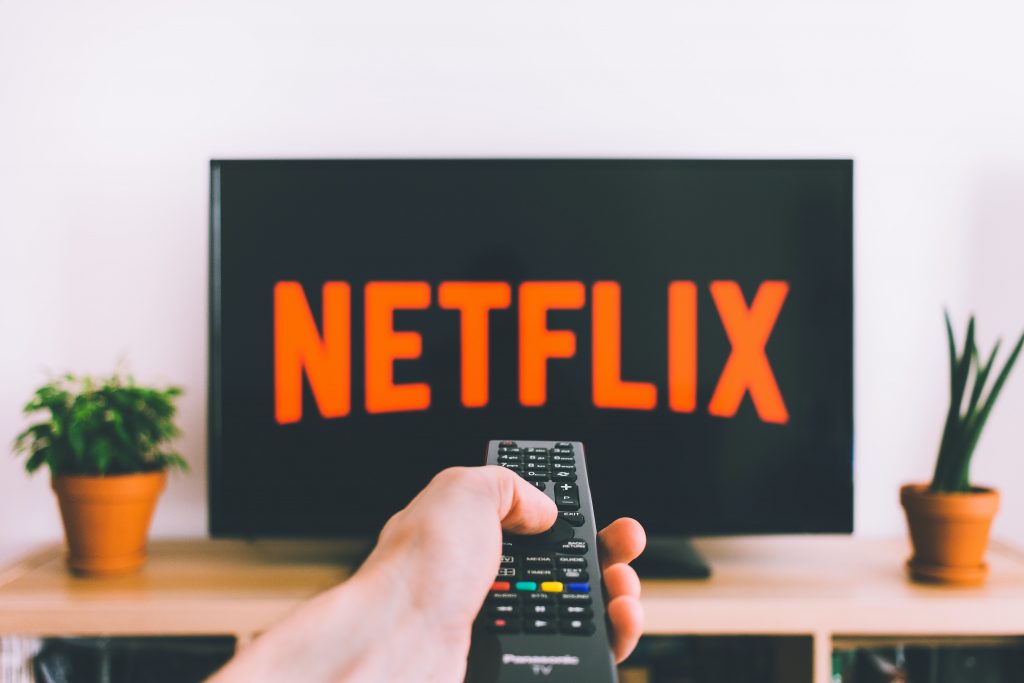
Constant streaming, scrolling, and virtual meetings have us glued to our screens for many hours each day. It’s important for the health of our eyes and our minds to cut it off once in a while. Give your brain a break and clear your mind with some time spent outside.
We spend so much time watching others live life on a screen, we sometimes forget to live it ourselves. There’s plenty of adventure and experiences for you, right outside your door.
Stay Safe in the Sun
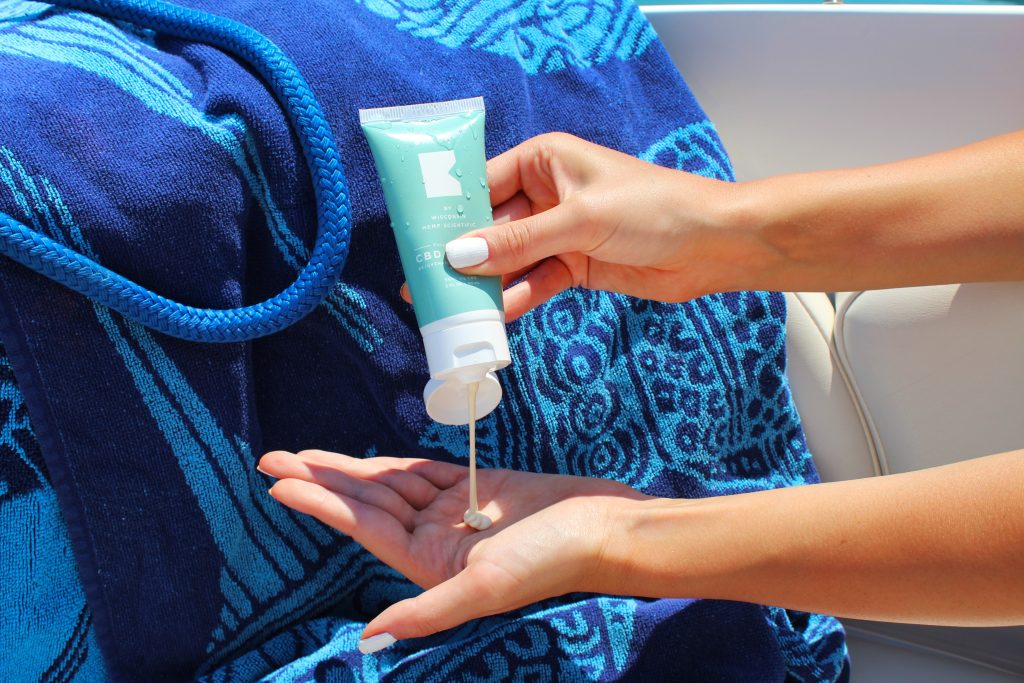
With extra time outside, it’s important to keep in mind some safety precautions. Remember to use sun protection, especially when the sun’s rays are most intense. From about 10 am until 4 pm, the sun is high in the sky and our skin is most likely to suffer damage if left unprotected.
Wear a hat and use a minimum 30 SPF sunscreen when you’ll be exposed to the sun for longer than 10 minutes. As the temperature outside increases, be sure to stay well hydrated. Keep a bottle of water handy at all times.
Make it a goal to get outside for at least an hour each day! It will greatly improve your mood and your overall health.
UV Safety Tips: Simple Ways to Protect Yourself from Harmful UV Rays
Tuesday, June 23rd, 2020
We all know we need to protect ourselves from the sun. UV radiation can be harmful to our skin in multiple ways. It speeds up the aging process, suppresses the immune system, can cause sunburn, and increases our risk for skin cancer. Even synthetic UV rays from tanning beds can cause harm to our skin often creating an even higher risk of skin cancer.
During the month of July, we observe UV Safety Month. Throughout the month we will spread awareness about various ways to protect ourselves from harmful UV rays. Are you providing yourself and your loved ones with full protection? We want to share a few tips to make sure you aren’t missing anything.
Seek Out the Shade

During the Sun’s most direct rays, between 10 am and 4 pm, it’s important to seek out the shade when possible. If there’s no shade available, bring your own! A broad-rimmed hat or ball cap can provide extra shelter from the sun for your face. The skin on your face is one of the most vulnerable to the sun since it is always exposed.
Remember that UV rays may still be able to reach you, even in shade. This is most likely when you are near reflective surfaces like sand, snow, or water. So wear your sunscreen even in the shade.
Understanding SPF: Sun Protection Factor

What SPF should you be looking for in your Sunscreen? What does it even mean? SPF or Sun Protection Factor indicates how long you will be protected in the Sun. If you wear an SPF of 10, your skin will take 10 times longer to burn than it would if left unprotected. However, the FDA recommends using a minimum SPF of 15 and most doctors recommend a 30 SPF minimum.
No matter what SPF you choose, experts also say you should reapply every 2 hours. More frequent reapplication may be necessary when swimming or excessively sweating.
It’s also important to note that SPF only protects against UVB rays. UVB radiation damages the skin causing sunburn. But UVA rays penetrate deep into the skin causing aging and also posing the risk of skin cancer. Choosing a sunscreen labeled, “broad spectrum” or “full-spectrum” will protect against both UVA and UVB rays.
Don’t Forget these Hidden Spots

It’s easy to remember that we need sunscreen on our shoulders, back, arms, and legs. What about those places we commonly miss? Be sure to protect your ears, the part in your hair, and the tops of your feet. Lips are another important, but easily forgotten part of the body to protect. Wear a lip balm with SPF and reapply frequently.
Harmful UV rays are partly responsible for vision-related problems like macular degeneration and cataracts. So be sure to protect your eyes with sunglasses specifically labeled with 99% UV protection.
More UV Safety Tips
For more information on UV Safety Month, visit our Wellness Observance Calendar. You can also receive a free download of our entire 2020 Calendar to stay up to date on future Wellness Observances throughout the year.
5 Reasons Why People Don’t Exercise
Monday, March 30th, 2020
This May is National Physical Fitness and Sports Month. We know that exercise is such a crucial element to good health. However, approximately 70% of people in American are overweight and out of shape. Heart disease is still our number one killer and the average American spends five hours in front of a television screen daily. This wellness observance is an excellent time to promote fitness at any level and work to lessen those numbers. Here we will address some common reasons why people may not exercise and offer some suggestions to overcome them.
Reason #1. “I have no time to exercise.”

This is perhaps the most common misconception about exercise. Many of us have very busy, hectic schedules. But the reality is that what we make time for reveals our priorities. You may think you have no time to exercise, but do you have time for all the health complications that may come from a sedentary lifestyle?
Time is relative. Each of us has twenty-four hours in a day. Take a look at your daily calendar and make a note of what you actually do to fill each hour. You may not have time to devote two hours at the gym every day. However, nearly everyone has ten to twenty minutes a day. You can take a brisk walk on your lunch break or after dinner each night.
Often times we believe that if we can’t do something the “right” way or invest in it the way we think we should, we can’t do it at all. But if we truly understood the value of consistency over time, we would realize how even small efforts make a big difference. Where our health and fitness is concerned, 20 minutes a day of exercise can make all the difference in the world.
Reason #2. “I can’t afford a gym membership or personal trainer.”
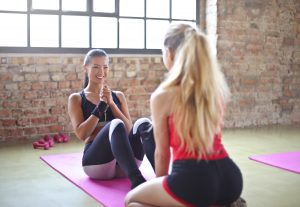
With technology being what it is today, you really don’t need a gym membership to get in shape. You may still enjoy the social, community aspect of fitness. Join a Facebook group or on-line fitness group. Accountability is great, but it doesn’t have to cost money. Even meeting up with a friend can be a great way to stay motivated and get healthy together.
There are plenty of workout videos for free on platforms like YouTube and Pinterest. Find your favorite fitness blogger to follow on Instagram for diet and exercise tips and programs. The number of resources is plenty, but that can also be overwhelming, especially to a beginner. Start small and go from there. Perhaps choose one workout plan or video to stick with first and then branch out as you progress in your fitness.
You don’t really even need technology or a gym. Just get outside and move your body! Have a private dance party in your own bedroom, play a game of basketball, go for a swim. The main idea is just to get up and move every single day. Get your heart-rate up and build muscle. Your body will thank you for it.
Reason #3. “I have bad knees/back/other health issues.”
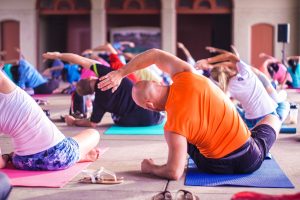
It’s certainly a legitimate concern when you have underlying health issues that make it more challenging to exercise. However, it’s only more detrimental to your health to let them stop you. Be sure to consult your doctor about what exercise may be beneficial to you. Do you have bad joints? Exercises like walking, the elliptical machine or swimming may be your best options. There are even some seated workouts available.
Don’t hesitate to modify strength training exercises to fit your needs. When you are carrying a lot of extra weight, it can be difficult to perform certain exercises. Modification is a great way to get started. Gradually, as your fitness level improves, you may not need to modify. Many of your current health issues may even disappear as your habit of exercise increases your overall health.
Reason #4. “I have too much weight to lose. It won’t make much of a difference.”
It can be overwhelming to start an exercise program when you feel you have so far to go. Set small, incremental goals for yourself. Don’t expect changes in your body overnight. Your main goal in creating a habit of exercise should be just that – creating a habit. Exercise is part of a lifestyle. Losing weight or gaining muscle can be great benefits, but they should always come secondary to your health.
Take it one day a time and celebrate what your body is capable of doing! When you exercise, it isn’t to punish yourself for eating poorly. Exercise is a way to care for your body and your health.
Maybe you’re already thin and think you don’t need exercise. Thin does not equal healthy! Your heart and lungs still need exercise. Exercise is not about weight, but about health.
Reason #5. “I just don’t like to exercise.”

Maybe you genuinely just don’t like exercise. That’s fair! But if you don’t like to do something, it is very easy to find reasons not to do it. If you don’t like an exercise, don’t do it! Find something you do like to do. Don’t like running? Don’t run. Simply walk or ride a bike. Take a dance class or take up yoga. You have plenty of options to choose from. Exercise can be fun! You just have to find the right fit for you. The more you enjoy it, the more likely you are to stick with it!
Visit our National Wellness Calendar to learn more about National Physical Fitness and Sports month.
Read our Wellness Blog on Promoting Observances in your workplace.
Managing Your Allergy Symptoms Naturally
Sunday, March 29th, 2020
Spring is in the air – and so is pollen. It’s that time of year when seasonal allergies are at an all time high. Over the counter allergy medications help, but most of us prefer a natural remedy when we can find one. Sometimes OTC medications just aren’t doing enough to relieve the severity of your symptoms. We have gathered some all natural ideas for you, but be sure to run them by your doctor to make sure they’re the best options for your specific case.

Your Body’s Response to Allergens
Your body senses allergens as a foreign, negative agent that needs attacking! It produces proteins called “histamines” to get to work and eliminate the allergens from your body. These create symptoms in your body like itchy, watery eyes, runny nose, sneezing, scratchy throat even atopic dermatitis. Even though these symptoms are uncomfortable, it’s evidence that your body is doing a good job!
What your body needs to ease these symptoms is anti-histamines and anything that reduces inflammation in the body. If we can reduce inflammation, we can reduce the severity of symptoms. There are plenty of natural agents that combat inflammation and we’ll talk about several.
Reducing Inflammation
There are so many natural aids that deal with inflammation in the body. We’re going to choose just a few to discuss here, but feel free to do your own research on other options you may have.

Vitamin C is everybody’s favorite immune booster, but with good reason! It is one of the most powerful antioxidants, which is incredibly beneficial since allergies create oxidative stress in the body. It’s also an excellent anti-inflammatory and 2 grams of vitamin C daily can act as an anti-histamine. Whether in supplement form or in your diet, make sure you’re getting plenty of Vitamin C to start.
Bromelain is another popular anti-inflammatory. It’s an enzyme found naturally in pineapple, but you can also find it in supplement form. It’s been used as a treatment post surgery, and has been found especially helpful for inflammation in the sinuses.
Probiotics are essential for good gut health and gut health boosts your immune system. But where allergies are concerned, your immune system may be in “hyper-drive” or over reacting. Taking a good probiotic (They are not all created equal. Do your research and consult your doctor.) will help bring balance back to your immune system, reducing inflammation in the body and lessening the body’s overactive immune response.
Milk Thistle & Turmeric are both great liver support. When your body is full of toxins, your liver is working hard and may struggle to eliminate allergens. This may make your allergy symptoms worse. Be kind to your liver by reducing your intake of fatty, fried foods, alcohol and sugar. Taking a supplement containing milk thistle and turmeric can be very beneficial for detoxing your liver and may lead to a decrease in your allergy symptoms.
Eliminating Allergens
We can’t very well stay locked inside all day, every day and most of us don’t want to. But there are some simple ways we can try to eliminate a few of the allergens that trigger symptoms, without lessening our quality of life.
Taking frequent showers, especially after spending extended time outdoors will help to wash away allergens that you are carrying on your body or in your hair. Vacuuming frequently and changing your pillowcase often can also help.
Change your air filter regularly. Invest in a dehumidifier to eliminate extra moisture that may be contributing to any mold or mildew growth in your home. You may also try an air purifier to help eliminate other airborne allergens and improve the overall quality of air that you breathe in your home. Many individuals have seen incredible differences in their allergies from the use of an air purifier.
Nasal irrigation by means of a nettipot or a simple saline spray have also proven very effective at relieving respiratory symptoms. They can help to flush out any allergens residing in your nose and keep things moving along.
Exercise is A Cure All
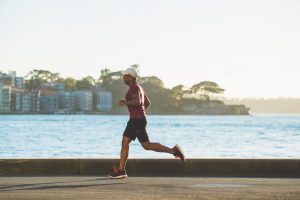
Studies have shown that exercise has a profound effect on the reduction of allergy symptoms. Although, no one really knows why. One reason may be that it’s a great stress reliever and less stress leads to less overall inflammation. Regardless, the benefits of exercise are so numerous, that you can only be better off by trying it.
Please visit our National Wellness Calendar for more information on Asthma and Allergy Awareness Month coming this May, as well as other Wellness Observances.
Promoting Bike Month in the Workplace
Saturday, March 21st, 2020
There’s a growing movement that increases health, builds community and decreases pollution – bicycling! Each May since 1956, we observe Bike month to encourage this movement to grow and spread health and wellness. In 2020, Bike to Work Week will be May 11–17, with Bike to Work Day on Friday, May 15. This is a very simple health activity that you can encourage in your workplace in a variety of ways. Healthier and more active employees are happier, more productive employees. Did you know that 40 percent of all commutes are two miles or less? That makes them the perfect length for a bike ride!

Bike Events
Planning a Bike Month Event is a great way to promote National Bike Month! The League of American Bicyclists has lots of resources for event ideas and promotional materials. Here are just a few ideas!
CAR VS. BUS VS. BIKE COMMUTER RACE –
Organize a race between cyclists and other commuters. Everyone leaves at the same time, with the same destination, but take very different routes. Surprisingly, cyclists usually win! It’s a great way to show one of the many benefits of taking a bicycle to work. Many first-time bike commuters become regular cyclists afterward.
BREAKFAST OR ENERGIZER STATIONS –
Set up stations in various neighborhoods where bicycle commuters can stop by for breakfast! You can even ask local restaurants to donate food for the event. Providing reflective bands or blinking lights and additional bike “swag” is another fun way to promote the event.
NATIONAL BIKE CHALLENGE –
Bike Week and Bike to work day are great, but signing up for the National Bike Challenge keeps it going all month. Encourage your employees to register online at www.nationalbikechallenge.org where they can track their miles, build community, and even win prizes! It’s a fun way to be competitive and incentivize bike riding.

Benefits of Bicycling
HEALTH –
80% of all cyclists say their health has improved since beginning to bicycle. With obesity on the rise, bicycling to work is a great way to get regular exercise into a busy schedule. Those who bicycle are typically leaner, fitter, have lower blood pressure and healthier cholesterol levels.
Stress levels also decrease with bicycle commutes. It can be very freeing and relaxing to go on a bike ride. Typically, cyclists are also able to avoid traffic congestion which can be a huge cause for stress for regular car commuters.
SAVE MONEY –
According to an analysis by the League of American Bicyclists, Americans saved more than $4.6 billion by bicycling instead of driving in 2012 alone. Bike commuters avoid parking ticket costs, gasoline prices, and various other car maintenance expenses. The cost of a year’s bike maintenance is a mere $300-400 as compared to an average of more than $8,000 for a car.

ENVIRONMENT/ECONOMY –
Cars are the number one contributor to environmental pollution. Short trips in the car are more harmful to the environment than longer ones. So switching to bicycles for those shorter trips cuts down on 3.6 pounds of pollutants per mile!
Besides air pollution, parking costs and space are exponentially less for bicycles. Ten bikes can fit in one parking space. The cost of parking is astronomically more for cars than bikes. Parking for 75 bikes can be constructed for the same price of 4 cars.
Studies have shown that cyclists stop by local businesses more frequently and spend more money there. Bicycle commuters also take 15% fewer sick days and are generally more productive at work.
For more resources and information on National Bike Month, Bike Week, and Bike to Work Day, visit our National Wellness Calendar.
Healthy Feet on the Job
Wednesday, February 19th, 2020
Our feet do the grunt work by supporting our entire bodies every day. They carry us from place to place from infancy through adulthood covering upwards of 100,000 miles. Our feet are the very foundation for our bodies but are typically ignored until there’s a problem. Once there’s a problem, it can affect our entire body’s overall health. Since our feet work so hard for us, why don’t we take care of them before any problems begin? Let’s go over some ways we can care for our feet and keep them healthy as they carry us through both our workday and life.
Proper Footwear
Wearing shoes with little to no arch support can wreak havoc on your body. Not only does a good supportive shoe provide a steady foundation and balance, but it also contributes to your overall activity level. Your arch comes under the most strain as you stand and walk. Without support, you may experience back pain, foot pain, and even headaches or stomachaches.
It can be challenging to find proper footwear when you work in an environment that requires more formal attire. Purchase a good shoe insert to make even the least supportive shoes more foot health-friendly.
If you can wear a shoe with laces at work, choose one with multiple eyelets. The more a shoe has, the more it can conform to the shape of your foot, providing the best support.
Moisturize
There are plenty of lotions and creams out there that are touted as the best for your feet. Any of them will do. The real trick to moisturizing your feet is to make sure you are first exfoliating. Get rid of any dead skin cells so that your dry feet will be ready to receive new moisture.

You can use a simple washcloth after soaking your feet, or a loofah or pumice stone for those extra dry, callused areas. Adding some Epsom salt to your bath can help soften the skin on your feet, making it easier to remove any dead skin.
Follow your exfoliation with a lotion or petroleum jelly to seal in moisture. Most of all, be consistent. Your feet crave moisture daily. Make sure your body is also hydrated from the inside by drinking plenty of water and eating a diet rich in Omega fatty acids.
Good Foot Hygiene
It’s easy to ignore our feet when it comes to hygiene. They’re typically covered inside a shoe, so who’s really going to see them? They’re also a long way down there! May we suggest you take the small extra effort to pay special attention to your feet? Here are some issues that may arise from poor hygiene and how you can prevent and address them:
- Ingrown toenails – ingrown toenails can be painful and uncomfortable. Be sure to keep your toenails trimmed, but not too short! Trim your toenails straight across rather than rounding the edges. Maybe most important, choose shoes that fit your foot properly! Shoes that are too tight can contribute to an ingrown toenail. Your toes should be able to wiggle freely inside.
- Smelly feet/shoes – This is a common problem for shoes that you may wear daily. Feet sweat and when they are inside a sock and shoe for over eight hours a day, that doesn’t leave much room for air circulation. Sometimes you are left with a shoe that stinks no matter what you do! In order to prevent those perpetually smelly feet, try to alternate between at least two different pairs of shoes for work. This allows one pair to completely dry out for over 24 hours. It won’t stop your feet from sweating, but it should allow the smell to decrease. Also, wear cotton socks to wick sweat away. Socks made of other materials may trap moisture in and worsen the issue. Choosing leather shoes over plastic or other synthetic material can also promote more air circulation to your feet.

- Infections/Itchy Feet – there are many different causes for itchy feet and not all of them relate to hygiene. However, one that does is a fungal infection we all know as “athletes foot”. Athlete’s foot can develop if your feet sweat and you’re wearing shoes that are too tight. Make sure your shoes fit properly and that you change out of sweaty socks as soon as possible. Even washing your feet with antibacterial soap can be helpful, paying close attention to in between your toes.
- Dry, cracked heels – Feet tend to be exceptionally dry. If you’re someone who spends a lot of time on their feet, your dry heels may even crack. These cracks leave your feet open and susceptible to infection. Use a thick moisturizer on your feet each night before bed and especially after washing to lock in moisture. Resist the urge to be barefoot as much as possible since it can lead to drier feet and the potential for infection.
April is Foot Health Awareness Month! Visit our National Wellness Observance Calendar for more resources on Foot Health as well as a FREE Calendar download. See our Wellness Blog on Workplace Wellness for tips on how to bring this education into your workplace.
10 Healthy Meals for Your Work Week
Monday, January 20th, 2020
We all know we should eat more healthily. Many of us simply don’t have the time it takes to plan and prepare healthy meals. We want to help you take the guesswork out of what to eat this week. We’ve gathered 5 healthy, easy to prep and pack for work lunches and 5 fast, easy and delicious dinners for each work night this week. That’s 10 healthy meals for your workweek.
Healthy Lunches to Pack for Work
- Hummus and Veggie Wraps – These are a great, tasty way to get in extra veggies. Use whatever veggies you have on hand. You’ll get extra protein from the hummus and by adding some deli meat or grilled chicken. Switch out white flour tortillas for some whole wheat or low carb options to increase your nutrients.

Photo belongs to laurenslatest.com
- Deli Snack Box – The options are truly endless when it comes to creating a deli snack box. Include a veggie, fruit, cheese, protein, and carb. These snack boxes are light while still being filling and full of variety, color, and good nutrition.

Deli snack boxes can be as varied and unique as the people who eat them.
- Kale Salad – If you’ve never tried a Kale Salad, you’re really missing out. Massage some olive oil into the leaves to soften them, add some lemon juice, slivered almonds, dried cranberries, and parmesan and you’ve got a delicious meal. Throw on some shredded chicken for some filling protein to round it out.
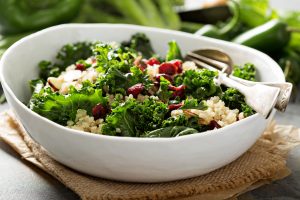
This Kale Salad uses quinoa as a great addition of protein and complex carbs.
- Tuna Salad Lettuce Wraps – Tuna salad is always a great go-to healthy lunch option. Wrapping it in lettuce instead of bread is a perfect way to reduce your simple carb intake and avoid that afternoon carb crash. If you’re trying to cut down on fat, try this mayo-free rendition of tuna salad, full of flavor.
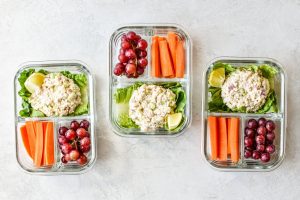
Photo belongs to projectmealplan.com
- Burrito Bowl – Rather than head to your favorite burrito bowl restaurant, save ten bucks by packing your own! You’ll save money and calories by building your own, simple burrito bowl.

Photo belongs to everydaymealprep.com
Easy, Healthy Weeknight Dinners
- Burger Bowls – Burger bowls are a super easy, fast, low carb meal to throw together on a weeknight. Grab a bag of sweet potato chips or frozen sweet potato fries as a low maintenance side item.
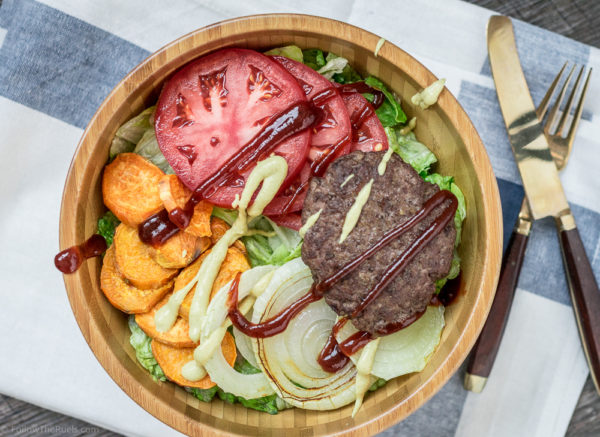
Photo belongs to thehoneyblonde.com
- One Pan Balsamic Chicken – Any recipe with “one pan” in the title is a winner! Easy preparation and easy cleanup. This delicious 30-minute dinner from Better Homes & Gardens is sure to be a favorite.
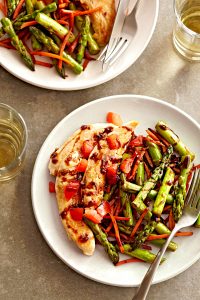
Photo belongs to bhg.com /Jason Donnelly
- Slow Cooker Stuffed Pepper Soup – This soup is our only slow cooker meal on the list, so it does require a little extra prep work. It’s still super simple and easy and once you’ve thrown it all in, it can cook away while you’re at work. The soup also makes great leftovers for lunches the next day.

Photo belongs to recipesthatcrock.com
- Avocado Salmon Rice Bowl – Here’s a meal that’s full of healthy fats and omega-3s. You can purchase bags of frozen salmon fairly inexpensively. You can also swap the white rice for brown or even buy a bag of frozen cauliflower rice to increase nutrient density.
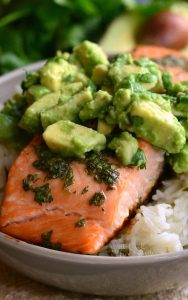
Photo belongs to willcookforsmiles.com
- Cauliflower Crust Veggie Pizza – You can purchase a frozen cauliflower pizza crust in your local grocer’s freezer section. Sometimes they even come with two crusts in a box! Add some pizza sauce and your favorite toppings for a healthy variation on pizza night.

Add extra veggies to pack in even more nutrients into this guilt-free pizza!
March is National Nutrition Month! Visit our Wellness Calendar for a free download of the upcoming Wellness Observances. If you’re interested in hosting a health fair at your workplace, check out our FREE planning tools. If you’re a healthcare provider, register a booth at a health fair near you!
Ditch the Diet for a Healthier You
Monday, November 25th, 2019
Each New Year begins the same for so many people: a new hope that this will be the year to finally get in shape. A quick google search tells us that 70% of people make a resolution to eat healthier, while roughly 50% resolve to exercise more and lose weight. However, according to the New York Post, most people give up on these goals by January 12th. In fact, only 8 percent of people actually achieve their New Years goals while 80 percent fail.
Start Small, Keep it Simple
One of the reasons cited for the failure of these new habits is that people try to change too much, too fast. We’re a “microwave” society. We want results and we want them quickly. To truly achieve a healthy weight, it takes time and consistent effort.
Don’t try to change everything about your life from New Year’s Eve to New Year’s Day. You’ll burn out quickly and become easily discouraged at your inability to sustain these dramatic new habits. Change one small thing and then another. Focus on habits you can control rather than the results you hope for. Nothing you do can physically move the number on a scale. But you can commit to eating more fruits and less sugar. You can commit to eating green veggies at every meal and drinking less soda.
Start with something small that you know you can do. Make it so easy it almost seems silly. Then, once you’ve stayed consistent for a week or two, add something else. You’ll build self-confidence and a habit of consistency. As you stay committed to the small things, your capacity for the bigger things will come.

Don’t Diet
One of the biggest detriments to our long term success is touted as being the number one way to achieve a healthy weight. Dieting just doesn’t work. By dieting, we mean any form of diet or eating habits that you use to achieve weight loss, with no intention of continuing to eat that way forever. Any diet that deprives you or drastically restricts your calories is a diet that will not work long term. You may reach your goal weight, but as soon as you return to normal eating habits, the weight will also return.
Those who achieve a healthy weight and are able to maintain it, eat normally. Everything in moderation with your main source of nutrition coming from lean meats, fruits, veggies and even whole grains and dairy is the best way to fuel your body.
Your body is smart and it will tell you when you’re hungry and when you’re full. You should listen to it! Some of us have forgotten how, but we can pay attention and relearn our bodies cues. You will find yourself happiest and most fulfilled when no food is a “bad food” or “cheat food”. It’s all just food. Some options are healthier, yes, but you can eat some of everything.
Move Your Body
Exercise doesn’t have to be complicated. It doesn’t even have to be two hours at the gym every day! Find some activities you enjoy doing. Maybe you want to start taking a class at the gym or sign up for dance lessons. Even a simple 10-minute walk twice a day may be more movement than you were doing before. It will make a difference when done consistently over time.
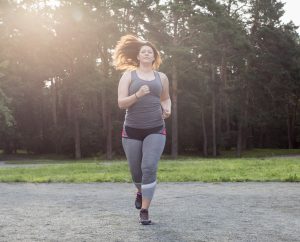
Mindset is Everything
Make up your mind that there is no “goal weight” or size clothing or look that you must achieve. Decide to be healthy no matter what. Even if the scale never moves, even if you look the same, even if it seems like nothing is changing, you’re going to stick with it. As soon as your healthy eating habits and exercise become just that – habits – the change will come. Maybe it won’t be exactly the way you thought, but maybe it will be even better! Most of us give up without ever having been consistent enough to see the fruit of all our effort. We stop just shy of seeing the results. This time, decide you’ll keep going.
If you miss a few days or even a few weeks, don’t throw in the towel! Press the reset button and get right back to it. You’ll find your body rebounds faster the more it’s used to a healthy lifestyle. You’ll begin to see results sooner than you did before.
Disease prevention begins, first and foremost, with your diet and exercise. Achieve your healthy weight to look and feel great, of course. But ultimately, it’s so much more than that. When you take care of your body, you lengthen your life span and your quality of life. You are well worth it.
Visit our Wellness Observance Calendar for additional resources on Healthy Weight Week, observed January 19-25, 2020.

